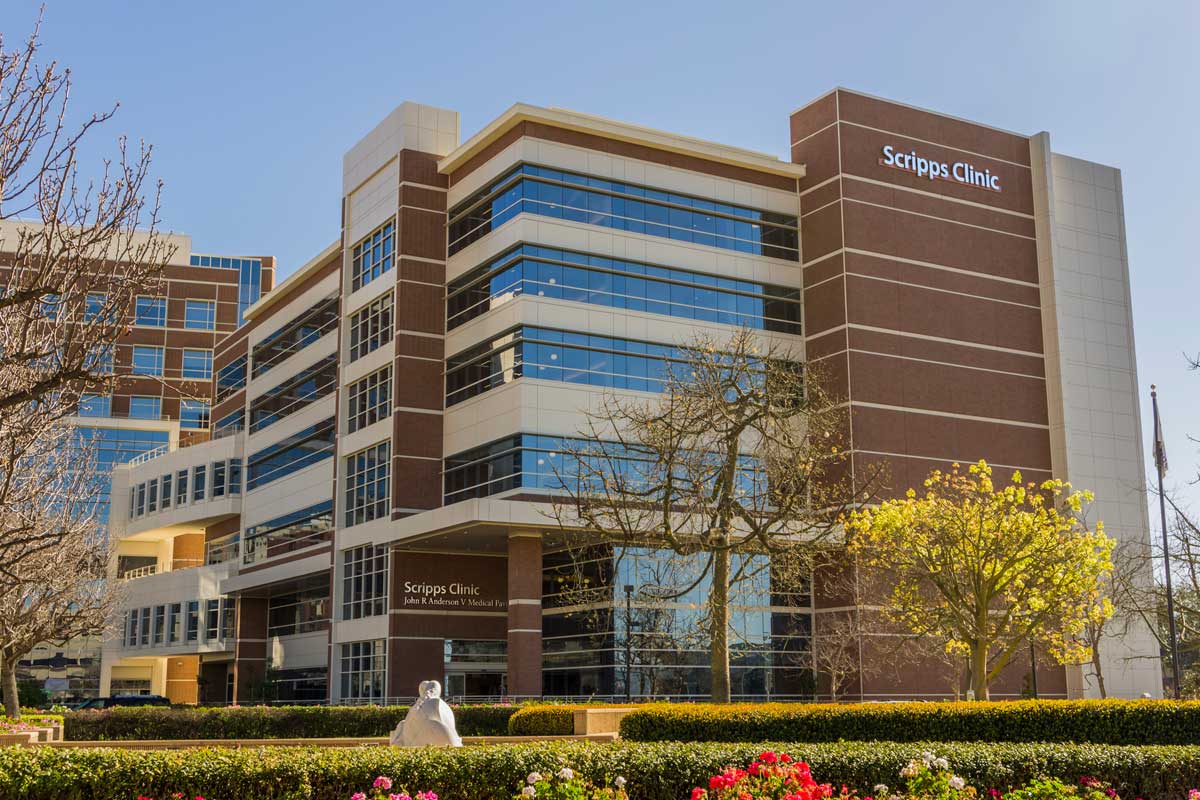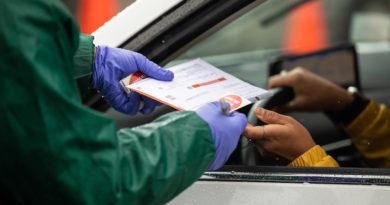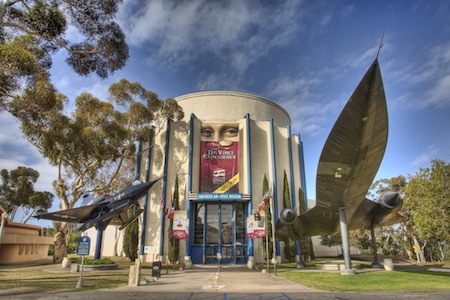Daily Business Report-Aug. 8, 2017
View of Anderson Medical Pavilion, located on the campus of Scripps Memorial Hospital La Jolla. (Courtesy of Scripps Health)
Scripps La Jolla Hospitals Take Top
Local Spot in Annual Hospital Rankings
The combined programs of Scripps Green Hospital and Scripps Memorial Hospital La Jolla rank No. 1 in the San Diego region, and are among the best in the nation in eight specialties, according to U.S. News & World Report’s annual Best Hospitals list, which was released today.
“Ranking No. 1 in San Diego and among the best in the nation is the result of the hard work of our physicians, nurses and staff who focus every day on always getting better,” said Chris Van Gorder, president and CEO of Scripps Health. “While we are deeply honored by this recognition, it’s really our patients who are the winners because they have access to outstanding health care right here at home.”
The annual U.S. News Best Hospitals rankings, now in their 28th year, recognize the nation’s top 50 hospitals that excel in treating patients with the most challenging health care needs. For 2017-2018, U.S. News evaluated hospitals in 16 adult specialties and ranked the nation’s top 50 hospitals in 12 of those specialties based largely on hard data.
Only 3 percent of the 4,658 hospitals that were analyzed by U.S. News & World Report were nationally ranked in at least one specialty.
The combined programs of Scripps La Jolla and Scripps Green hospitals (called “Scripps La Jolla Hospitals and Clinics” on the list) were nationally ranked in eight specialties: Gynecology (No. 10), Diabetes and Endocrinology (No. 14), Pulmonology (No. 15), Cardiology and Heart Surgery (No. 21), Gastroenterology and GI Surgery (No. 25), Orthopedics (No. 34), Geriatrics (No. 36) and Nephrology (No. 39).
State ranking and metro rankings
U.S. News ranked the best regional hospitals in 45 metropolitan areas with a population of a million people or more based largely on the number of national rankings achieved. The combined programs of Scripps Green and Scripps La Jolla were ranked No. 1 in the San Diego metro area and No. 6 in California.
Other high-performing areas
U.S. News also recognizes high-performing hospitals in specialty areas that were not ranked in the top 50 but scored among the top 10 percent of hospitals that received scores. The combined programs of Scripps Green and Scripps La Jolla were designated as High Performing in cancer, neurology and neurosurgery, rheumatology and urology. Scripps Mercy Hospital San Diego was High Performing in nephrology.
In addition to ranking hospitals by treatment of the most challenging cases, U.S. News & World Report also ranks hospitals by performance treating nine relatively common adult procedures and conditions. The combined programs of Scripps La Jolla and Scripps Green achieved the highest score possible, and were designated High Performing in all nine categories: abdominal aortic aneurysm repair, aortic valve surgery, heart bypass surgery, heart failure, colon cancer surgery, chronic obstructive pulmonary disease, hip replacement, knee replacement and lung cancer surgery.
Scripps Mercy Hospital San Diego was listed as High Performing in heart failure, colon cancer surgery and chronic obstructive pulmonary disease.
Programs at the hospitals were recognized for excellence in several areas including discharging patients to their homes instead of another hospital or nursing facility, survival rates, nurse staffing levels, patient experience and preventing complications and prolonged hospitalizations.
___________________
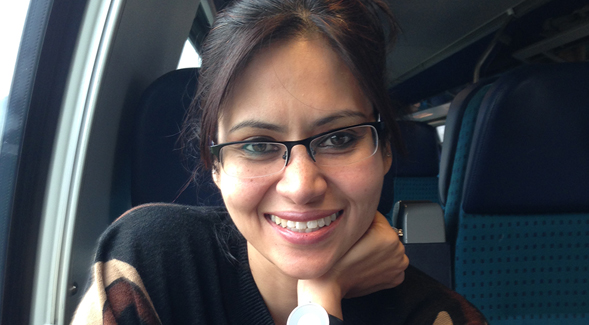
Creating Alternative
Communication Highways
SDSU researcher studies the use of brain-computer interface technology
By Katie White | SDSU NewsCenter
Mahasweta Sarkar is on a mission to create life-changing connections. The San Diego State University associate professor in the Department of Electrical and Computer Engineering is investigating whether biosensors implanted in the brain could transmit signals wirelessly to paralyzed arms in individuals with spinal cord injuries. The primary goal is to restore mobility in the upper limbs of such individuals.
Sarkar is part of the Center for Sensorimotor Neural Engineering,
a collaboration between researchers from SDSU, the University of Washington and the Massachusetts Institute of Technology that is supported by $35 million in funding from the National Science Foundation (NSF).
SDSU’s participation in the multi-university consortium underscores its commitment to research collaboration. The SDSU Engineering and Interdisciplinary Sciences Complex, slated to open early next year, will provide even more opportunities for faculty and students to find innovative ways to collaborate across labs and disciplines.
She and her collaborators are using “glassy carbon” electrodes
developed by Sam Kassegne, a fellow CSNE researcher at SDSU, to capture brain signals. These bio-compatible electrodes are surgically implanted in the human brain where they record commands that the brain routinely transmits to the limbs.
In a healthy individual, these signals travel through the spinal cord and associated nerves to the intended parts of the body. For instance, if the brain generates a signal for the hand to pick up an item from a table, muscles in the hand interpret that signal and move to execute the brain’s command.
In patients with spinal cord injuries, the body’s natural communication highways are damaged. Although the brain is capable of producing the same command, it doesn’t reach the hand.
Bypassing natural pathways
Sarkar and her team are working to develop an artificial communication highway that avoids damaged nerves in bypassing the natural journey brain signals take through the spinal cord. Her method would allow the signals captured by the implanted electrodes to be passed to a low-power transmitter, which would wirelessly send the brain signals to a muscle stimulator located on the paralyzed limb.
Before the technology can be tested in the human body, it must undergo rigorous testing to determine how deep inside the brain tissue the wireless transmitters will have to be implanted, as well as how much power can be used to transmit the brain signals without causing damage to the brain.
“Right now, we are trying to figure out how the combination of blood, water, tissue fluid, tissue and bones affects the wireless signals,” said Sarkar. “To do that, we are testing the performance of the low-power neural transmitters in chemical solutions that mimic the body’s natural environment.”
So far, the team has focused on studying the transmission from a single implantable neural transmitter. Sarkar hopes to transmit signals from many such transmitters within a year and believes her current research could be applied to humans within the next decade.
Sarkar has presented her work at numerous scientific conferences and published her research in several recent academic journal articles. She won the best paper award in 2013 for “Ultra Wideband Transceiver Design for Compact and Implantable Medical Devices,” work that appeared in the Proceedings of the International Conference on Communications Systems and Technologies.
Inspiring the next generation
In addition to her research work, Sarkar was recently tasked by the CSNE to lead its education efforts for the next generation of neural engineers. In her role as the CSNE’s education co-director, Sarkar hosted the first-ever Young Scholars Program (YSP) at SDSU over the summer.
The free-to-attend, NSF-funded two-week summer camp allowed 14 local middle and high school students to explore the neuroengineering field’s opportunities for both patients and researchers alike.
As part of the camp, students programmed a computer chip to rotate a motorized propeller with just the power of their minds. They utilized a headset that captured EEG signals from the brain, then wrote software code to wirelessly translate the headset wearer’s level of attention into rotation by the motorized propeller.
“The camp consisted of a pool of really bright future scholars, and I thought it was remarkable that an equal number of boys and girls participated,” said Sarkar. “I am hopeful that my work within the CSNE will encourage and motivate the next generation of both male and female scholars to pursue neuroengineering careers.”
___________________
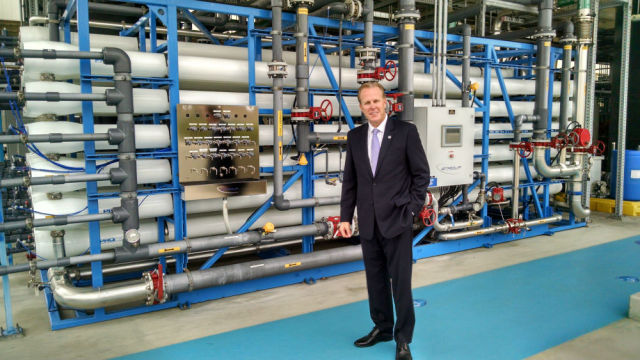
EPA Permit Paves Way for City’s
Landmark Water Recycling Project
San Diego’s landmark water recycling project got a major boost Monday when the Environmental Protection Agency renewed a permit for the aging Point Loma Wastewater Treatment Plant
The new five-year permit allowing ocean discharge from the plant means the city won’t have to spend $1 billion or more on upgrades and can instead invest that money into the largest water recycling plant in the United States.
“This is huge for San Diego because we’ll be able to avoid unnecessary and expensive upgrades at the Point Loma plant and can instead invest those dollars to create an independent, drought-proof water supply for our residents,” said Mayor Kevin Faulconer.
“With this permit renewal, the EPA is showing strong support for our Pure Water recycling program as we chart a path toward water independence,” Faulconer added.
Pure Water San Diego is the city’s program to provide one-third of San Diego’s water supply locally by 2035 through recycling wastewater instead of pumping it into the ocean.
A prototype plant is already in operation in Miramar, and the first phase of a larger facility is expected to break ground next year and open in 2021.
The finished recycling plant would provide 30 million gallons of water a day, which would be mixed in reservoirs with water from traditional sources.
Last month, the EPA invited the city to apply for a $492 million federal loan to help fund the initial phase of the multi-billion-dollar recycling project.
___________________
Sullivan Solar Power installs first LG
Chem battery in the Continental U.S.
The same kind of battery used in thousands of electric vehicles on the road today has been installed in a Carlsbad home — the first residential installation in the continental U.S.
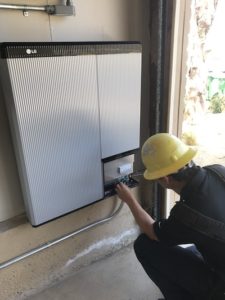
“This is solar power of the future, today,” said Daniel Sullivan, founder and president of Sullivan Solar Power, which installed the battery at the home of Bob Keefe, executive director of a national organization that advocates for smart policies that are good for the economy and the environment. “We’re trying to move away from fossil fuels, and we now have the technology to make homes invisible to the grid, power your car and business and it’s less expensive than sticking with the dirty utility company,” said Keefe. “If these batteries are reliable enough to power cars at 70 mph on dark road at night and reliable enough for military, it’s good enough to sit in my garage, capturing and storing the energy created from my solar.”
Keefe is an applicant for California’s Self-Generation Incentive Program (SGIP), which provides preferential rebates for batteries that are paired with solar power systems. SGIP launched May 1 and is a multi-step program where incentives reduce over time.The San Diego Gas & Electric rebate is being administered by Center for Sustainable Energy, and is entering step three of the program. The typical amount given to homeowners in step three of the program is slated to be $3,160. Southern California Edison territory is in step two of the program, where the typical homeowner receives a $3,630 rebate for their battery with solar.
___________________
Community College District Gets High
Marks for Prop. V Construction Program
For the third year in a row, the Grossmont-Cuyamaca Community College District has received outstanding marks for providing open information about its Proposition V construction bond program.
The district received 24 out of 25 points possible from the San Diego Taxpayers Educational Foundation for the transparency of GCCCD’s Prop. V program. The taxpayers foundation released its annual transparency scorecard July 25 for the 23 school and college districts in San Diego County with active facilities bond programs.
Proposition V, the $398 million construction bond approved by East County voters in fall 2012, paved the way for the district to continue the work started with Prop. R – the $207 million facilities bond passed in 2002 that resulted in the construction or renovation of 13 major facilities at the colleges.

